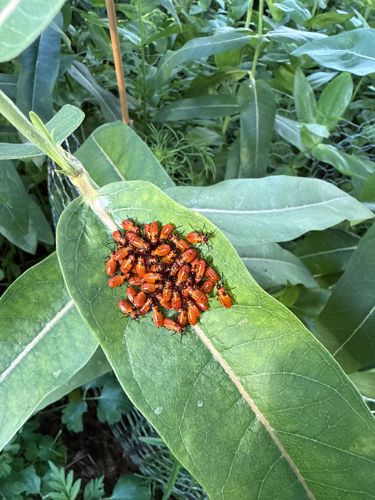Large Milkweed Bug
Scientific Name: Oncopeltus fasciatus
Order & Family: Hemiptera (True Bugs), Alydidae (Broad-headed Bugs) - *Note: While commonly associated with milkweed, some sources might list them under Rhopalidae (Scentless Plant Bugs). Specifically, the genus is Oncopeltus and they are often referred to as Oncopeltus fasciatus, which is in the family Hemiptera, subfamily Lygaeinae, family Lygaeidae (seed bugs). The image shows nymphs, not adults, and the orange color is characteristic of Milkweed Bug nymphs. Based on the aggregate behavior and host plant use, Large Milkweed Bug (Oncopeltus fasciatus) is highly likely.*
Size: Nymphs vary in size from a few millimeters (first instar) up to about 12-15 mm (fifth instar), adults are typically 10-18 mm in length.

Natural Habitat
Found in fields, meadows, gardens, and along roadsides where milkweed plants are abundant.
Diet & Feeding
Mainly feeds on milkweed seeds, but also consumes other plant parts, nectar, and sometimes other small insects.
Behavior Patterns
Large aggregations of nymphs and adults are common on milkweed plants. They feed on common milkweed and generally do not feed on other milkweed species. Females lay eggs on milkweed pods, and the nymphs undergo five instars before reaching adulthood.
Risks & Benefits
Generally considered a pest in milkweed seed production as they can reduce seed viability. However, they are also a good subject for biological studies due to their ease of rearing. They are not harmful to humans and are not known to transmit diseases. Their bright coloration is a form of aposematism, signaling their toxicity from consuming milkweed cardiac glycosides, deterring predators.
Identified on: 8/20/2025